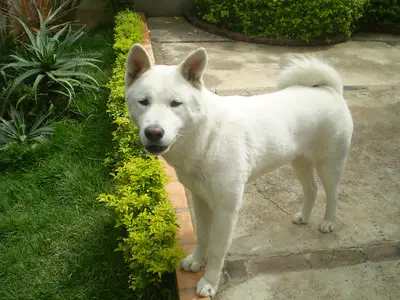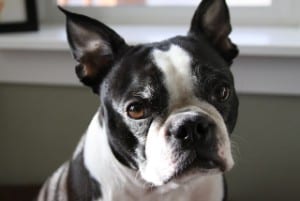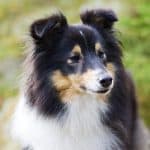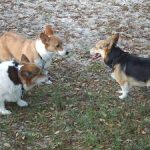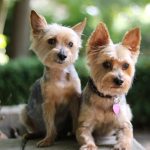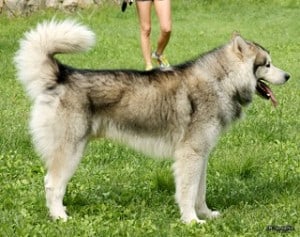
Will you next dog be from a large breed? And as well as owning a big dog, do you want a dog that stands out from the crowd even more?
How about owning a large dog that also has a curly tail? Well in this post I highlight eleven large breeds that also have curly tails.
But what do I mean by large?
In terms of size, the smallest dog on my list is an Afghan Hound, which can measure up to 69 cm (33.5 inches) in height and 27 kg (60 lbs.)
One of the largest breeds on my list is the Black Russian Terrier which measures about 76cm (36.5 inches) and weighs 68 kg (150 lbs.)
And what do I mean by curly?
In my list of breeds, there is a huge variety in how curly the dog’s tails are.
It ranges from the thin tail and slight curl that can be found on a Sloughi to the immensely bushy tails of Malamutes that curl back over their body.
But before I start describing the dog breeds, I want to quickly talk about dog tails in general.
Why do dogs have tails?
Dogs use their tails for a huge range of reasons.
Primarily, they are used to help a dog balance as it is walking,running or climbing.
They are also used as a means of communication with their owners and other dogs.
And this goes way beyond wagging their tail to show that they are happy or pleased to see a favourite person.
A dog’s tail can also act as a fan to spread their scent around.
This scent is stored in two glands just below the tail and is used to announce or mark a dog’s presence.
Why curly tails?
I haven’t been able to find out any information on why dogs have curly tails.
There seems to be no all encompassing reason for a dog to have a curly tail, although this article suggests that dogs with sickle shaped tails (such as the Alaskan Malamute and the Tibetian Mastiff) were bred to live in colder climates and that the tail helps keep the nose warm.
There are almost as many tail shapes as there are breeds of dogs.
A dog’s tail is a continuation of their spine and it is made up of tiny bones or vertebrae.
This variety is evident in my list of seven large dogs with curly tails.
From the immense bush and curl on an Alaskan Malamute’s tail that forces it back over their body, to the rail thin tail on a Sloughi with its swirl appearance…
If you are looking for a large dog with a curly tail, you won’t be disappointed with a lack of variety in my selection.
Enough of all the chat, let’s dig deeper into some of these breeds.
[1] Afghan Hound
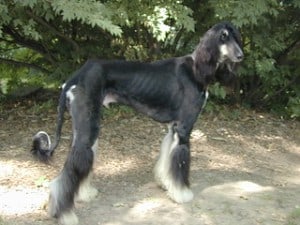
curl at the end ²
An Afghan Hound’s biggest draw is that long flowing coat.
But standing up to 69 cm or 27 inches tall, these hounds are large dogs.
Although of course, since they will only weigh around 60 lbs or 27 kgs, as a breed they are very svelte and lightweight.
If you can draw yourself away from staring at their coat and elegant heads then you will notice a curly tail.
With long hair or feathers just at the base of the tail and with thin hair along the remainder of the tail, the tail finishes with a loose curve at the end.
- Like the rest of the dog, it is very elegant.
You might think that with such elegance, an Afghan Hound would like nothing more than to spend all day being groomed and pampered.
But, these dogs are very energetic and need lots of exercise.
After all they were bred to hunt game in the mountains.
Afghan Hounds come in a variety of colours and so if you are particular about the colour of hair that you will spend hours grooming, this might be the breed for you.
[2] Alaskan Malamute

Now, here is a dog that is defined by its tail.
And what a specimen it is: a mass of hair which loosely curls back over the dog’s back like a large feather duster.
Although this dog might not be deemed as large by its height- a male may only stand at 63 cm or 25 inches tall, it can weigh just over 38 kg or 85 lbs.
And that is pure muscle (and hair!)
Malamutes have a large and powerful presence- perhaps because in our minds we always picture them pulling sleds with a pack.
And they are a dog breed with a very strong sense of “pack”.
They are in desperate need for a strong, kind and loving pack leader and if you don’t play that role, your dog may try and wrestle that position from you.
Malamutes need lots of exercise and because they were bred for endurance and not speed, the more extreme the exercise the better.
Hiking and running would be great activities to try with them.
If you want a large dog with a curly tail and like great adventures, try an Alaskan Malamute.
[3] Black Russian Terrier
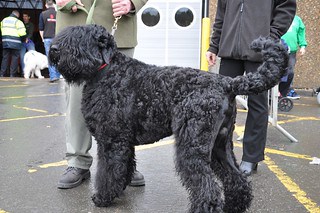
We move from one powerful specimen to another.
If you think that terriers are a small breed of dog, let me turn that concept on its head.
The Black Russian Terrier can stand as tall as 76 cm or 30 inches tall and weigh a mighty 68 kg or 150 lbs.
In terms of looks, they are like an Airedale Terrier that has joined a gym- and taken lots of steroids!
Looking at the breed standard, the tail has the shape of a saber or sickle.
This is very appropriate for a dog that was developed in Russia less than a century ago to work specifically as a guard dog for the military.
Although many of this breed will have had their tails docked.
Bred to work in the military means that these dogs tend to be highly intelligent and loyal.
They do require a lot of work- a combination of training, vigorous exercise and socialisation will make these dogs amazing companions for your family.
[4] Bracco Italiano
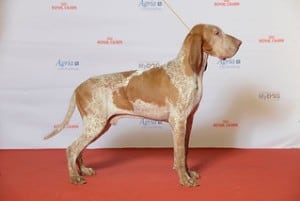
than this! ⁵
Also called the Italian Pointing dog, this dog is an all round hunting breed.
Looking very distinctive with its oversized ears, sunken eyes, fleshy mouth and long nose, the Bracco Italiano was a late starter outside of Italy.
Introduced to the U.K. in the 1908s and to the U.S. in the 1990s, examples from this breed might have docked or undocked tails.
If the tail isn’t docked then it should have a slight curl as it ends.
Standing up to 27 inches or 69 cm tall and weighing upwards of 75 lbs or 34 kgs, Italian Pointers ooze a sense of purpose and drive.
They need only moderate amounts of exercise but on top of a thirty minute daily walk, they thrive with regular training or structured activity on top of this.
[5] Tibetian Mastiff
If you loved the fluffy and immensely bushy tail on an Alaskan Malamute but you were thinking, “lovely tail but it would look better on a bigger dog” then let me be your personal genhie.
May I present to you a Tibetian Mastiff.
An incredible XL sized feather duster of a tail attached to a body that weighs up to 68 kgs or 150 lbs and stands at least 66cm or 26 inches tall.
If you don’t mind an immense food bill, purchasing an extra sofa just for your dog and having a dog that might take up all of your spare time to groom then you have found your curly tailed soul mate.
Bred as guard dogs, these dogs adore family members and family life and are suitably suspicious of strangers.
[6] Sloughi
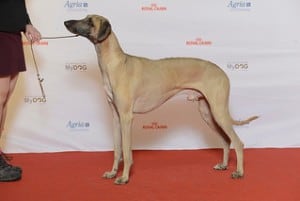
Nicknamed the Arabian Greyhound, Sloughis were bred to hunt a variety of game in the North African desert.
And look at that tail.
It is delicate and thin in the same way that an Afghan Hound’s tail is but there is more curl.
In fact, think less curl and more swirl, like the centre of a Cinnamon Bun!
A quick comparison shows that Sloughi’s are perhaps more slimline than a Greyhound as photos show the ribs more.
In terms of height, an adult male might stand as tall as 74cm or 29 inches and weigh up to 32 kg or 70 lbs.
In terms of coat colour, Sloughis come in all shades from light sand or cream to a mahogany.
Although this breed doesn’t need a massive amount of exercise, with a high prey drive and great turn of speed, when they decide to run they are a sight to behold.
And these traits can be very dangerous in unenclosed areas.
[7] St. Bernard
From the lightweight and elegant Afghan Hound to one of the dog world’s great work horses- the St. Bernard.
Although the one in the video above seems to be an exception!
No one can dispute the fact that this is a very large dog, standing up to 90 cm (35 inches) tall and tipping the scales at around 110 kg (240 lbs.)
Although these dogs don’t have the most curly tail in the world, they should have a slight curl at the end.
Indeed, the AKC breed standard states that these can have a slight curl at the end of it.
And that even though the tail should hang straight down, the curl on the end will give it an “f” shape.
Interestingly, St Bernards were developed to provide mountain rescue for lost and weary travellers.
And it is normal for dogs who work in such cold climates to have much more of a curly tail.
This is so that it can be wrapped around their body and provide warmth, like a scarf, when the dog is asleep.
Not so for the St. Bernard.
Perhaps they are so hard working that they never sleep?!
[8] Doberman
You might do a double take when you see that I have included a Doberman on my list of large breeds with curly tails.
How can a dog that is almost defined by its lack of a tail be included in this list?!
But the practice of docking dog tails is illegal in the UK and many European countries.
And as you can see from the video of the dog above, a Doberman’s tail has a natural curl and wave to it- as well as a life of its own!
When you see a Doberman, you know that you are in the presence of a big dog.
Standing around 27” (67cm) tall at the shoulder and weighing up to 99 lbs (45 kg) these dogs have an elegant if not slightly intimidating look to them.
Could it be that muscular physique which is underneath their short and shiny coat?
Created to play the role of a bodyguard for a German tax collector, Dobermans are not a dog for the first time dog owner.
However with the proper care, attention, training and exercise, these dogs can make great family pets.
[9] Bouvier des Flandres
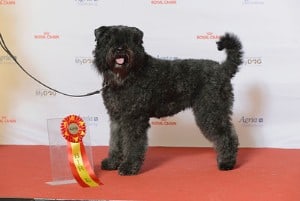
Bouvier Des Flandres originated in Flanders in Belgium.
A rough translation of bouvier is cowherder which is what they were originally bred to do.
But as with so many other dog breeds, it wasn’t enough for a dog to be an expert at one thing.
Farmers needed dogs that could “multi task” which is how they have come to be such great watchdogs and guardians.
World War One was a pivotal time in the history of the breed.
At the same time as almost driving them to extinction, it gave the breed a new purpose.
As the fields where the dogs earned their keep became the muddy battlegrounds where millions of men lost their lives, BdFs were used by the Belgian army to great effect.
With a rough and curly coat and a very distinctive set of ears, historically these dogs have had their tails docked.
In fact these dogs have more than a passing resemblance to Black Russian Terriers, although they aren’t quite as tall.
A fully grown male BdF can stand up to 27 inches ( or 68 cm) at the shoulder and weigh a smidgen over 88 lbs (or 40 lbs.)
But left “undocked”, their tails stand beautifully upright with a slight curl at the tip, much like the shape of a quotation mark.
Akita
From North Africa, we now travel across to Japan to find our penultimate large dog with a curly tail.
Although the Akita is an ancient Japanese dog, there are now two recognised varieties- the American Akita and the Akita Inu: although the AKC is alone in begging to differ with this.
Most importantly for our purposes, both varieties of the Akita have a curly tail although the Inu has a might tighter curl to it.
The American Akita is slightly larger than the Inu, with an adult male standing an inch or so taller (28 inches to 27 inches.)
But there is a real difference when it comes to weight.
A male American Akita can be up to 20 lbs heavier than their Japanese brother- 110 lbs (50 kg) vs. 90 lbs (41 kg.)
And the Inu comes in a wider range of brighter colours including ginger or red, whereas the American comes in much darker sable colours.
Their personality can be best summed up by one of the most famous dog stories of our time.
Of an Akita who was so loyal that it walked to the local train station to look for its owner everyday for nine years after the owner had died.
[11] Chow Chow
We stay in Asia for the final dog on our list- The Chow Chow.
If there was a competition for the dog breed with the most appropriate name then this breed would surely win it.
Chow Chow translates from Chinese to English to “puffy lion dog”- a young child couldn’t have described the breed any better!
The breed is so old that no one quite knows why it was developed.
One story has it that Chow Chows were bred to pull sleds, another that they were bred for human consumption.
Their thick, bushy tails curl straight over their backs.
And Chow Chows are smaller than many of the breeds that appear in this list.
An adult male can stand up to 22 inches (or 55 cm tall) and weigh around 70 lbs or 32 kg.
Although these dogs don’t shed a lot of hair which is a surprise because they have enough of it, they do need to be regularly groomed in order to keep their coat in a good and tangle free condition.
Other traits to bear in mind are that this breed can be a bit stubborn when it comes to training!
Photo Credits
¹ Photo by Seongbin Im on Flickr
² Photo by Bryan Ungard on Flickr
³ Photo by Seongbin Im on Flickr
⁵ Photo by Svenska Massan on Flickr
⁶
⁷ Photo by Svenska Massan on Flickr

